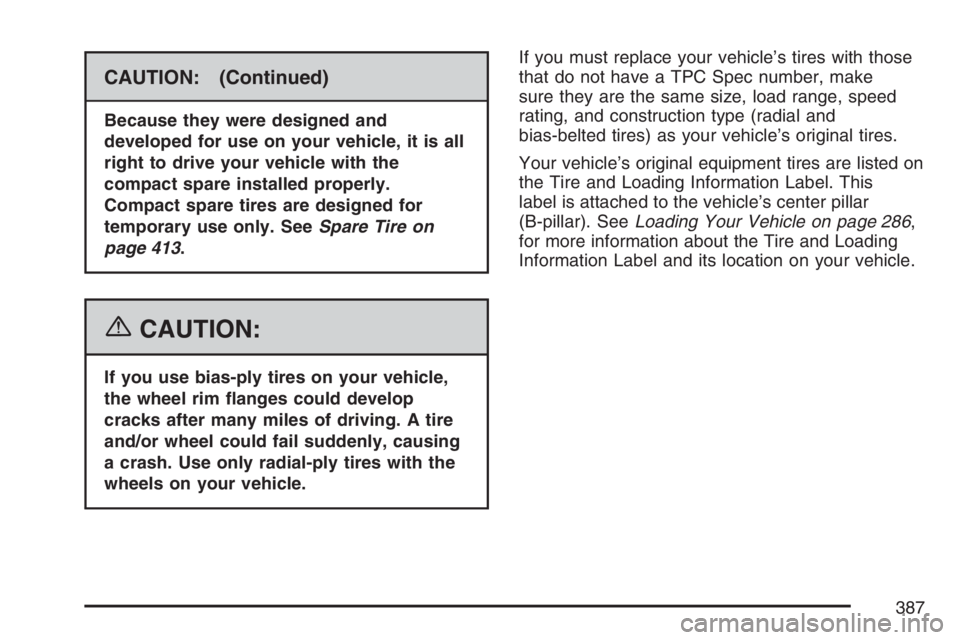Page 384 of 492

When rotating your tires, always use one of the
correct rotation patterns shown here.
If your vehicle has a compact spare tire or a spare
tire that does not match your vehicle’s road tires
and wheels, in size and type, do not include
the spare in the tire rotation.
After the tires have been rotated, adjust the front
and rear in�ation pressures as shown on the
Tire and Loading Information label. For the location
of the Tire and Loading Information label see
Loading Your Vehicle on page 286. Make certain
that all wheel nuts are properly tightened, see
“Wheel Nut Torque” underCapacities and
Speci�cations on page 430for the proper wheel
nut torque speci�cation.
{CAUTION:
Rust or dirt on a wheel, or on the parts to
which it is fastened, can make wheel nuts
become loose after time. The wheel could
come off and cause an accident. When
you change a wheel, remove any rust or
dirt from places where the wheel attaches
to the vehicle. In an emergency, you can
use a cloth or a paper towel to do this;
but be sure to use a scraper or wire brush
later, if needed, to get all the rust or dirt
off. SeeChanging a Flat Tire on page 394.
Any time you rotate the vehicle’s tires the Tire
Pressure Monitor System (TPMS) will need to be
reset. The TPMS identi�cation codes will need
to be matched to the tire and wheel position. See
“TPMS Sensor Identi�cation Codes” underTire
Pressure Monitor System on page 378.
384
Page 387 of 492

CAUTION: (Continued)
Because they were designed and
developed for use on your vehicle, it is all
right to drive your vehicle with the
compact spare installed properly.
Compact spare tires are designed for
temporary use only. SeeSpare Tire on
page 413.
{CAUTION:
If you use bias-ply tires on your vehicle,
the wheel rim �anges could develop
cracks after many miles of driving. A tire
and/or wheel could fail suddenly, causing
a crash. Use only radial-ply tires with the
wheels on your vehicle.If you must replace your vehicle’s tires with those
that do not have a TPC Spec number, make
sure they are the same size, load range, speed
rating, and construction type (radial and
bias-belted tires) as your vehicle’s original tires.
Your vehicle’s original equipment tires are listed on
the Tire and Loading Information Label. This
label is attached to the vehicle’s center pillar
(B-pillar). SeeLoading Your Vehicle on page 286,
for more information about the Tire and Loading
Information Label and its location on your vehicle.
387
Page 412 of 492
7. Make sure the tire is stored securely. Push,
pull (A), and then try to turn (B) the tire. If the
tire moves, check to make sure the tire
valve stem is pointing down, then use the
wheel wrench to loosen and then tighten
the cable.To store the tools, do the following:
1. Return the wheel wrench, jack extensions and
the storage bag to the locations described
underRemoving the Spare Tire and Tools on
page 395.
2. Install the wheel blocks �rst. Then install
the jack.
3. Secure the items in the vehicle as shown next.
A. Jack
B. Wheel Blocks
C. Wing Nut
Crew Cab
412
Page 463 of 492

Emergency Tow From a Public Roadway or
Highway:Tow to the nearest dealership for
warranty service or in the event of a
vehicle-disabling accident. Winch-out
assistance when the vehicle is mired in sand,
mud, or snow.
Flat Tire Change:Installation of your spare tire
in good condition will be covered at no charge.
The customer is responsible for the repair or
replacement of the tire if not covered by a
warrantable failure.
Jump Start:No-start occurrences which
require a battery jump start will be covered at
no charge.
Dealer Locator Service:Information on the
dealer nearest your location.
Trip Routing:Your Roadside Assistance
Representative can provide you with speci�c
information regarding this feature.
Trip Interruption Expense Bene�ts:Your
Roadside Assistance Representative can
provide you with speci�c information regarding
this feature.
Additional Services for Canadian
Customers
Trip Routing Service:Upon Request,
Roadside Assistance will send you detailed,
computer-personalized maps, highlighting your
choice of either the most direct route or the
most scenic route to your destination,
anywhere in North America, along with any
helpful travel information we may have
pertaining to your trip. To request this service,
please call us toll-free at 1-800-268-6800.
We’ll make every attempt to send your
personalized trip routing as quickly as
possible, but it’s best to allow three weeks
before your planned departure date.
Trip routing requests will be limited to
six per calendar year.
463